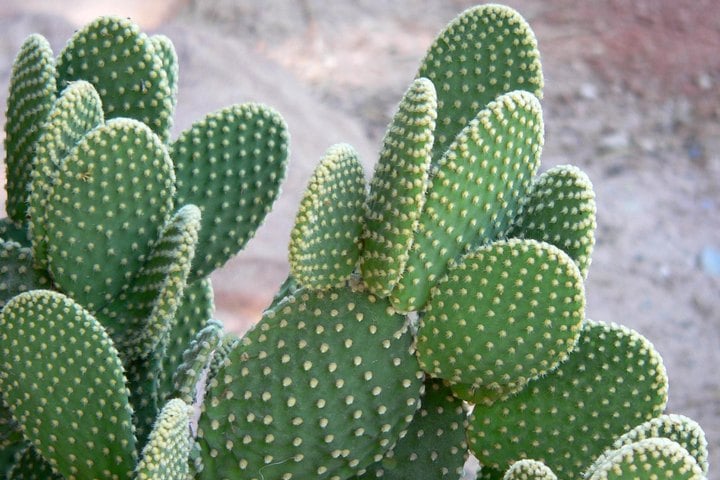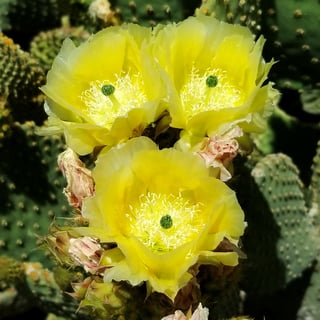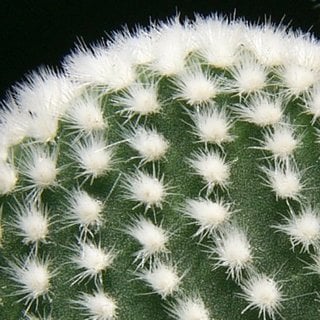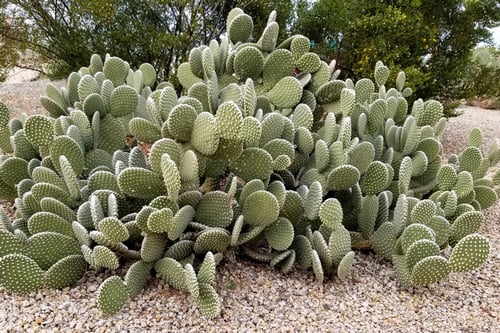With a name like “bunny ears” and its polka dot appearance, this cactus looks relatively harmless, but is deceptively hazardous. Here’s everything you need to know about this native Mexican cactus, so you can decide whether it’s a good choice for your garden, plus how to take care of any new or existing plants.

The first thing that stands out when you see a bunny ears cactus (Opuntia microdasys) is that it’s covered with an impressively uniform pattern of small dots. From a distance, it appears cute and fuzzy. And with a name like bunny ears, you might assume it’s a “friendly” plant — but do not touch!
The dots are clusters of tiny barbed spines called glochids. They can be white, yellow, or rusty brown, depending on the variety or subspecies.
New pads grow from the tips of older ones in pairs, forming the distinctive “bunny ear” form.
The yellow two-inch flowers bloom in spring and are followed by small, dark red fruits.
Bunny ears cactus is an extremely low-maintenance landscape plant. It is less prone to cochineal infestations than many other members of the prickly pear genus (Opuntia).
Why I Like This Plant
- Unique “polka dot” pads and “bunny ears” form
- Bright yellow flowers in spring
- Extremely low maintenance

Things to Watch Out For
Bunny ears cactus can grow quite aggressively and cover a large area in a few years. So make sure you’ve given it plenty of room to grow. You don’t want it encroaching where people or pets may brush against it.
Bunny ears cactus pads are actually thornless, but those polka dot clusters of glochids may be more hazardous than obvious spikes, which are easier to avoid. Even the gentlest contact with this cactus will cause glochids to dislodge and embed in your skin or clothing.
I was horrified to learn that these glochids are so light that they can become airborne. This means you may find them distributed elsewhere in your yard.
If you’ve ever had an encounter with glochids you’ll know that they are extremely annoying and difficult to remove. More than one gardener has cursed the day they planted this deceptively dangerous plant.

Optimal Growing Conditions
If you’re thinking of adding a prickly pear plant to your garden, you need to find a suitable place that will keep your plant healthy and looking good… while minimizing maintenance for you.
Here are the key factors to keep in mind.
Temperature
Bunny ears cactus should be grown in USDA Hardiness Zones 9 – 11. As a Chihuahuan Desert native, it can handle extreme heat and is cold-hardy down to around 15℉.
Sun Exposure
Bunny ears cactus thrives in full sun, but tolerates part shade.
Size and Growth Rate
Bunny ears cactus grows moderately fast. Plants typically reach 2 feet tall by 6 feet wide, but can sprawl into a large, dense mass up to 10 feet across.

Soil
Bunny ears cactus prefers well-draining alkaline soil that’s sandy or rocky.
If you grow one in a container, make sure the pot has drainage holes and use specifically formulated cactus soil. Note that when grown in containers, it rarely blooms.
Other Location Considerations
Since bunny ears cactus is blanketed with glochids and grows low to the ground, don’t plant this where curious children or pets can touch it. Don’t plant it anywhere that people might accidentally brush against it, such as near a patio or walkway.
Bunny Ears Cactus:
The Essentials
| Common Name | Bunny ears cactus |
| Scientific Name | Opuntia microdasys |
| Origin | Mexico |
| Plant Type | Segmented cactus |
| USDA Zones | Zones 9 – 11 |
| Cold Hardiness | To 15℉ |
| Flower Color | Yellow |
| Flower Season | Spring |
| Mature Size | 2-3′ high x 4-6’ wide |
| Growth Rate | Moderate |
| Sun Tolerance | Full, part sun |
| Water Needs | Low |
| Pests & Diseases | Root rot |
| Cautions | Glochids |
| Wildlife | Deer, rabbit resistant |
How to Plant
Dig a hole as deep as and twice as wide as the nursery container. Carefully remove the plant from the container, put it in the hole, and press the soil to remove any air pockets.
It’s generally recommended that you backfill with native soil and not add any amendments. However, good drainage is critical. So if you know your soil is slow draining, amend with coarse sand or small gravel until you have a loose, well-drained mix.
Plant your cactus facing in the same direction that it was in the nursery. Better nurseries will mark the pot so you know which direction your cactus has been facing. Surprisingly, cactus can get sunburned, and planting them in the same direction that they’ve been facing can minimize this.
When to Plant
The best time to plant cactus is in the spring or early summer when warm soil temperatures encourage root development.
How to Care for Bunny Ears Cactus
Whether you’ve recently planted a bunny ears cactus or have an existing plant in your yard, here’s how to take care of it to keep it healthy and looking its best.
How to Water
You’re probably used to giving plants a good soaking immediately after transplanting, but that isn’t the best practice with cactus. Counterintuitively, it’s best not to water them for one to two weeks after planting.
When your cactus is young, water it once per month during the hot spring and summer, unless you’ve had rains of ½ “ or more. It should not need any irrigation during the winter. Too much water can cause this cactus to rot.
Once established, this cactus should not need supplemental water unless there is severe drought.
Should You Fertilize?
There is no need to fertilize bunny ears cactus. This desert native has evolved to grow in poor soil.
But if you grow one in a container, fertilize lightly a few times a year when it’s actively growing.
Pruning & Propagation
This plant doesn’t need pruning except to remove dead or damaged pads. You can also prune to keep your plant’s size in check, you don’t have to. If you decide to prune, always cut at pad joints.
If you have extra pads, you can use them to easily propagate new plants. Let the pads dry and callous for a week or two and then stick the cut end in the ground or a pot. It’s recommended that you not water them for the next month to avoid root rot.
Plant Lover Facts
Bunny ears cactus (Opuntia microdasys) also goes by several innocuous-sounding common names — angel’s wings, bunny cactus, yellow bunny ears, rabbit cactus, and polka dot cactus.
Its species name microdasys means small and hairy.
It is native to Mexico but has naturalized in Arizona and can be found growing wild on most continents. It’s considered invasive in Australia.
Disturbingly, glochids of blind prickly pear (Opuntia rufida), have been known to get into the eyes of animals, causing blindness. This species is so closely related to bunny ears cactus that it’s often considered a subspecies (Optunia microdasys subs. rufida).
Did you enjoy this article?
Sign up for our weekly newsletter
where you’ll find more great info on creating &
maintaining a beautiful, carefree desert landscape.
Author Bio
Deane Alban is the creator of Southwest Gardener. She is a science writer with a bachelor’s degree in botany from the University of South Florida. Gardening is her lifelong passion. She’s been gardening in Tucson for over 15 years.

Photo Credits
Stan Shebs, CC BY-SA 3.0, Wikimedia Commons
Arizona State University’s Virtual Library of Phoenix Landscape Plants
Paul Kaluschke CC BY-SA 3.0, Wikimedia Commons
